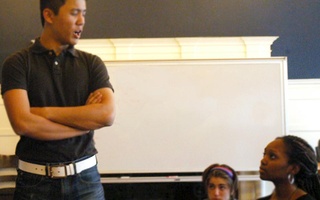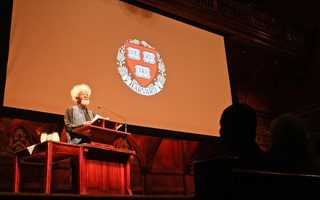There are pressing issues in life that often divert writers’ attention from their work, Soyinka says.
“Before one is a writer, one is a human being, one is a citizen. But when I finally get down to writing I try to take revenge for the periods of deprivation.”
‘CONSCIENCE OF NIGERIA’
In order to begin to understand Soyinka’s art, one must be familiar with the cultural and political environments of which he is a product.
Soyinka was born in 1934 at Abeokuta near Ibadan in the western part of Nigeria. At that time, the country was still a British colony and Soyinka was raised in an Anglican mission compound.
Although he received a Western education and writes in English, Soyinka was exposed to the rituals and beliefs of the Yoruba people by his paternal grandfather and his writings are firmly anchored in his ethnic heritage.
At age 11, Soyinka joined the protest movement to free Nigeria from British rule. Ever since that moment when Soyinka was first introduced to demonstration as a political tool, he has tirelessly campaigned for the spread of human rights and democracy throughout Africa.
In addition to challenging Abacha, whom Soyinka calls a “murderer with other nasty habits,” he fought to overthrow Idi Amin, Uganda’s cruel military dictator, and this past May he participated in a rally demanding the resignation of Nigeria’s president, Olusegun Obasanjo, whose re-election is said to have been tainted by vote fraud.
Soyinka’s activism has resulted more than once in his arrest and imprisonment. After the outbreak of civil war in Nigeria in 1967, Soyinka tried to negotiate a cease-fire with the Ibo secessionists. The government accused him of conspiring with the rebels and detained him, without trial, at the notorious Kaduna prison in northern Nigeria where he spent two years in solitary confinement.
He wrote extensively—mostly with homemade ink on toilet paper—during his incarceration. The opening stanza of “Live Burial,” one of several poems composed during that period and later published in his book A Shuttle in the Crypt (1972), provides a vivid glimpse into his consciousness:
Sixteen paces
By twenty-three. They hold
Siege against humanity
And Truth
Read more in Arts
YellowArrow Aimed at Building Art CommunityRecommended Articles
-
Du Bois Legacy CelebratedPoet Laureate Rita Dove, Nobel Prize-winning author Wole Soyinka and President Neil L. Rudenstine all praised W.E.B. Du Bois yesterday
-
Nobel Laureates Honor Wole Soyinka at IOPNobel laureates Nadine Gordimer, Derek Walcott, and Toni Morrison joined hundreds of audience members last night at the John F.
-
Author Speaks About SudanNigerian author Wole Soyinka, the first African to win the Nobel Prize for Literature, argued that the Arab section of
-
 Death and the King's Horseman
Death and the King's Horseman -
 Committee on African Studies Commemorates Mandela Three Months After Death
Committee on African Studies Commemorates Mandela Three Months After Death













